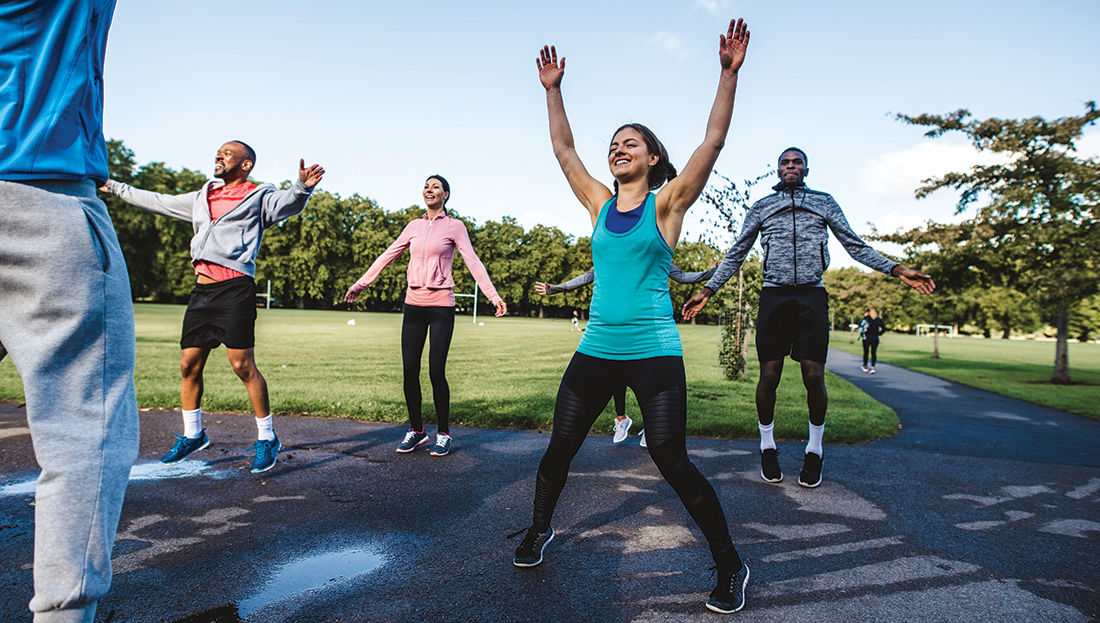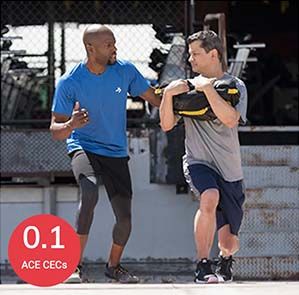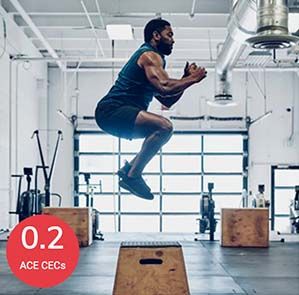Body-weight Interval Training: Equipment Free and Highly Versatile

As you well know, a healthy, physically active lifestyle is key to helping people live longer, healthier lives, and reducing the risk of a wide range of diseases, including cardiovascular disease, type 2 diabetes, hypertension, breast cancer and colon cancer. Yet, developing and maintaining a life-long, physically active lifestyle can be a significant challenge for many people. While there are numerous reasons why an individual is unable to be physically active on a regular basis, the most common barriers are lack of time, social support, energy and motivation; fear of injury; lack of skill or knowledge of how to exercise; weather conditions; high cost and a lack of access to facilities.
So, how do you, as a health and exercise professional, help your clients overcome these types of barriers? Excitingly, body-weight interval training (BW-IT) could be a highly effective solution to many of these common barriers. Plus, many of the newer workout designs (you’ll find examples later in this article) of BW-IT offer a fun way to engage participants while providing a great workout for experienced fitness enthusiasts as well as entry-level exercisers.
Combatting Sedentary Lifestyles
For many researchers who have focused on BW-IT, their interest was inspired by the principles of high-intensity interval training (HIIT), which has proven to be a time-efficient, popular workout strategy that effectively improves cardiorespiratory fitness and indicators of cardiometabolic health, such as fat loss and the body’s response to insulin (i.e., insulin sensitivity). Importantly, BW-IT requires no additional equipment and minimal space, as it requires participants to use their own body weight as resistance against gravity, performing multiple repetitions during work intervals to achieve an aerobic and muscle-strengthening stimulus.
Health and exercise professionals like you are seeking fitness solutions to increase participation in both aerobic and muscle-strengthening activities, while also reducing the sizable population of people who sit too much. New research on helping people who live predominantly sitting lifestyles to become more active is revealing some helpful intervention techniques that can be achieved with BW-IT programming. Here are four specific promising techniques to help people become and stay active with their BW-IT programming:
- Provide participants with clear instructions on how to perform the BW-IT workouts.
- Teach clients how to self-monitor their BW-IT workouts and exercise progress.
- Help individuals define their fitness and health goals and collaborate on creating an action plan to achieve them.
- Discuss the detrimental health consequences of sitting too much.
Interestingly, the research indicates that many people are still ill-informed of the health dangers of too much sitting. BW-IT provides a novel approach for helping people smoothly pivot from sitting behaviors into a physically active lifestyle.
What the Research Says About BW-IT
The great news is BW-IT programs offer participants positive health benefits. For example, one study of 30 healthy adults (18 to 30 years of age) compared the results of participants who completed 12 sessions of supervised and unsupervised (i.e., home-based training) BW-IT with those who did not participate (i.e., the control group). Both BW-IT programs demonstrated positive results in cardiorespiratory fitness and body mass index in as little as four weeks. The authors highlighted the fact that BW-IT, whether supervised or home-based, provided an appealing exercise intervention for adults, which could help counteract the negative chronic disease effects seen with the rise in a sedentary lifestyle.
Another study included 12 participants (men and women, average age 30 years) who completed a BW-IT workout and a treadmill HIIT workout. The treadmill HIIT workout consisted of two sets of five 60-second run intervals at 100% running speed (determined from a maximal aerobic capacity test), alternated with 60 seconds of recovery walking periods at 2.5 miles/hour. The BW-IT workout consisted of two sets of five 60-second “maximal effort” body-weight exercises, alternated with 60 seconds of recovery marching in place at 100 steps per minute. The results showed that high-intensity BW-IT can elicit cardiorespiratory and metabolic (i.e., blood lactate) effects, as well as ratings of perceived exertion, that are similar to a HIIT workout on a treadmill. Additionally, it is important to note that BW-IT takes up minimal space, requires no cost and has a lot of changeability in exercise selection, all of which are features that the treadmill exercise does not offer.
How to Introduce BW-IT to Your Clients
There are several variables to consider when designing BW-IT workouts, and the following recommendations stem from current research. These practical application tips can be seen as building blocks for developing an effective BW-IT program, and you’ll find several sample BW-IT programs at the end of this article. First, let’s discuss the variables to consider when designing BW-IT programs.
General Safety Suggestions: If your client will be completing their bodyweight BW-IT in a home space, remind them to make sure their workout environment is clear of obstructions, uneven surfaces (e.g., rug to hardwood flooring) and potential tripping hazards. They will need sufficient space for jumping and leaping exercises and should wear appropriate footwear. Importantly, minimize the potential for any slipping or falling.
Warm-up: A warm-up for BW-IT typically consists of light-intensity, rhythmic body movement (e.g., brisk walking in place or easy calisthenics) for five minutes. Be sure to incorporate any individualized musculoskeletal range of motion movements for each client; for example, clients with arthritic or bone-health conditions may need to complete some targeted dynamic stretching of certain joints. It is best to include movements in the warm-up that are specific to the predominant muscle groups used for the designed body-weight workout.
Exercise Intensity for Work Intervals: Using a subjective (e.g., ratings of perceived exertion) or objective (e.g., percentage of estimated maximal heart rate) measurement, encourage clients to exercise at an intensity that is moderate to very hard.
Exercise Intensity for Recovery Periods: As above, encourage clients to keep recovery intensities between low and moderate.
Length of Work Bout: Depending on the individual client’s fitness level, work intervals should be 20, 30, 45 or 60 seconds in duration. With entry-level exercisers, we recommend 20-second to 45-second work bouts.
Length of Recovery Periods: Recovery intervals should last between 10 seconds and 4.5 minutes, depending on the individual client. Longer recovery periods are encouraged for entry-level enthusiasts and less-fit clients.
Exercise Choice: The choice of body-weight exercises can be divided into those with cardiorespiratory emphasis and those with a muscular endurance emphasis, as presented below.
Cardiorespiratory BW-IT Exercises: Perform as many repetitions as possible, at the individualized exercise intensity, for the optimal cardiorespiratory stimulus. Always modify exercises for each client’s fitness level. Sample exercises include:
- High knees in place
- Heel to glute kicks in place
- Ski jumps
- Jumping jacks
- Burpees
Muscular Endurance BW-IT Exercises: With each BW-IT exercise, have clients focus on the muscle groups being used by squeezing the target muscles as they perform the movements. Importantly, emphasize performance technique of the movements to maximize the movement stimulus. Sample exercises include:
- Squats and jump squats
- Push-ups
- Alternating lunges
- Mountain climbers
- Body-weight Romanian deadlift (RDL); a single-leg RDL can be used for a greater challenge
Recovery Exercise Suggestions: During recovery periods, encourage clients to walk in place and/or perform easy-to-do calisthenics.
Cool-down: For the cool-down, have clients perform five minutes of lower-intensity rhythmic body movement followed by static stretches of the main muscle groups, holding stretches for 30 seconds. For additional mental health relaxation benefits, incorporate three to five minutes of slow deep breathing at the very end of the workout.
Sample Workouts
Tables 1 through 5 feature two cardio-focused BW-IT workouts, two muscular-endurance workouts, and one that combines both cardio and muscular endurance. Listed in each table are the exercises for the work bouts (feel free to change the order for variety), but you will need to select the recovery exercise that best suits each of your clients. Depending on the client’s fitness level, repeat the BW-IT workout one to three times.
Recommended Workout Durations
When planning the duration of your client’s BW-IT workouts, consider how much time they can realistically commit to these types of workouts each week. Research has shown that even short BW-IT workouts—as little as four minutes—can effectively enhance cardiorespiratory and muscular fitness. Research also shows that brief sessions of five minutes or less of vigorous exercise may improve glucose control. So, if your client is short on time, encourage exercises that provide a strong cardiorespiratory stimulus (see Tables 1 and 2). For a structured progression, you can follow these research-based recommendations:
- 10-minute workouts for entry-level exercisers (plus warm-up and cool-down)
- 15- to 20-minute workouts for intermediate to advanced exercisers (plus warm-up and cool-down)
Table 1. Cardiorespiratory Endurance Workout for Entry-level Exercisers
|
Exercise |
Performance Tip |
|
Marching high knees |
Keep the core engaged while lifting the knees. |
|
Step jacks |
Step out wide and fully extend the arms upward. |
|
Jogging boxers |
Punch with full body weight behind each punch. |
|
Stepping burpees |
If needed, place hands on a bench or chair. |
|
Side-to-side shuffle |
Maintain a slight bend in the knees. |
Table 2: Cardiorespiratory Endurance Workout for Experienced Exercisers
|
Exercise |
Performance Tip |
|
High knees |
Lift knees above hips and engage the core. |
|
Jumping jacks |
Land softly after jumping. |
|
High skips in place |
Jump while keeping hips facing forward. |
|
Burpees with a push-up |
Maintain a straight line from head to heels. |
|
X-Jumps |
Cross arms in front of the body at the bottom of the squat. |
Table 3. Muscular Endurance Workout for Entry-level Exercisers
|
Exercise |
Performance Tip |
|
Air squats |
Start by pushing the hips back. |
|
Lateral leg raises |
Point the toes and engage the core. |
|
Quarter squat press |
Keep the elbows up while lowering into the squat. |
|
Good mornings |
Place fingertips behind the head for support. |
|
Hip raise |
Push the shoulder blades into the floor. |
Table 4. Muscular Endurance Workout for Experienced Exercisers
|
Exercise |
Performance Tip |
|
Jump squats |
Push the ground away while jumping. |
|
Side lunges |
Sit back into the heel while lunging sideways. |
|
Squat thrusts |
Keep the hips down during the thrust. |
|
Single-leg RDLs |
Grip the floor with big toe for balance. |
|
Single-leg hip raise |
Squeeze the inner thighs together. |
Table 5. Combined Cardiorespiratory and Muscular Endurance Workout for Experienced Exercisers
|
Exercise |
Performance Tip |
|
Static sprints |
Pump the arms and legs as fast as fast as possible. |
|
Curtsy lunges |
Bend both knees to about a 90° angle. |
|
Scissor jacks |
Stay on the balls of the feet. |
|
Sumo squats |
Strive to lower the thighs parallel to the floor. |
|
Quick feet |
Keep the hips low and engage the core. |
Conclusion
Altogether, the data suggests that BW-IT is a viable home-based and/or supervised fitness workout that can easily be modified for all fitness levels. It requires minimal space and no added equipment, which may help some clients overcome several common barriers to exercise. Additionally, BW-IT may provide a smooth transition for non-exercisers to transition to a more physically active lifestyle.
Gabriella Bellissimo, PhD, ACSM-CEP, ACSM-CPT is an Assistant Professor in the Department of Health and Human Performance at the College of Idaho. With field experience in personal training, group exercise, and clinical settings, her professional passion is developing simple, adaptable physical activity interventions for diverse populations to promote exercise adherence and manage chronic disease.
Len Kravitz, PhD, CSCS, is a professor and program coordinator of exercise science at the University of New Mexico where he received the Presidential Award of Distinction and the Outstanding Teacher of the Year award. He also is a member of the ACE Scientific Advisory Panel.
Expand Your Knowledge
Looking for more information on how to effectively design training programs for your clients? Here are some great resources that also offer opportunities to earn the continuing education credits (CECs) you need to renew your certification.
A Movement-based Approach to Strength Training
What’s often missing in strength training programs is a movement-based approach, which allows exercise professionals to coach clients who need to improve strength for health or performance, not just aesthetics. In this video training, you’ll explore the theory of three unique forms of strength training: odd-position strength, dead strength, and agile strength, all applied within the framework of the newly updated ACE Integrated Fitness Training® (ACE IFT®) Model.
Increasing Speed Through Functional Strength
Go beyond drills and running form assessments, and dive into the intricacies of speed and strength. Equipped with practical application techniques, you’ll design purposeful programs for optimal results and help your clients boost speed and movement efficiency.
More Articles
- Certified™: September 2024
Train Like an Olympian: Two TRX Muscular Training Workouts
- Certified™: September 2024
Rethinking Ibuprofen: Important Considerations for Your Clients’ Health
Contributor
- Certified™: September 2024








